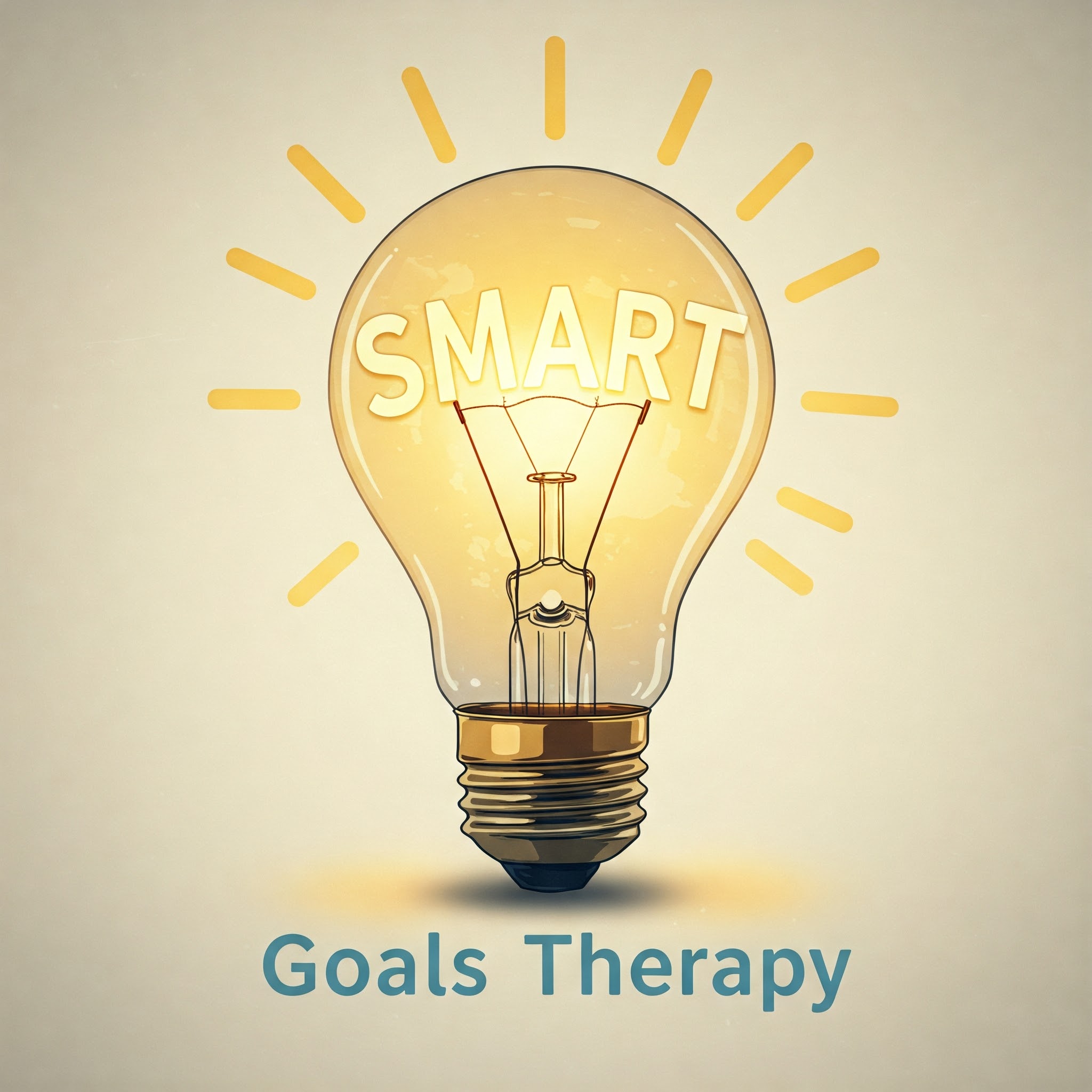Effective time management is essential in therapy, and one of the best ways to stay focused is through the use of SMART goals. Smart goals therapy helps clients and therapists turn broad intentions into clear, actionable plans with measurable outcomes. In this guide, you’ll learn how to set SMART goals, avoid common pitfalls, and use practical tools to keep therapy on track and results-driven.
Table of Contents
What Are SMART Goals?
In smart goals therapy, the term SMART is an acronym that stands for:

This framework is used to help clients and therapists create clear, structured, and realistic goals that can be tracked and adjusted over time. Instead of vague or open-ended objectives, SMART goals provide a roadmap for therapeutic progress.
Specific
A specific goal clearly defines what the client wants to achieve. It answers the questions: What do I want to accomplish? Why is this goal important?
Measurable
Measurable goals include criteria to track progress. This helps both the therapist and client see improvements and stay motivated.
Achievable
The goal should be realistic and attainable within the client’s current circumstances. Setting impossible goals can lead to frustration.
Relevant
A relevant goal aligns with the client’s personal values, needs, and the overall purpose of therapy.
Time-bound
Every SMART goal should have a deadline or a timeframe to create a sense of urgency and direction.
By using this method, smart goals therapy makes it easier to measure success, adjust plans, and empower clients to take control of their progress.
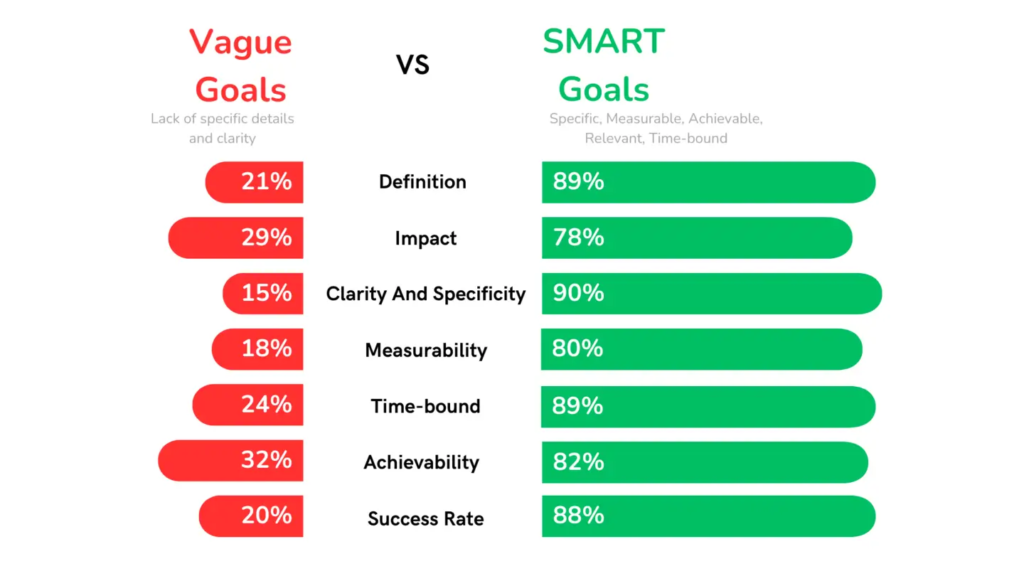
Benefits of Using SMART Goals in Therapy
Using SMART goals in therapy provides a clear structure for both the client and the therapist. Instead of setting broad intentions like “feel better” or “reduce anxiety,” smart goals therapy focuses on specific, measurable steps that lead to real progress.

Here are some of the key benefits:
1. Clear Direction
SMART goals help clients understand exactly what they’re working toward. This clarity reduces confusion and builds focus from the very beginning of the therapeutic journey.
2. Increased Motivation
When clients can see measurable progress, they often feel more motivated to continue. Tracking small wins builds momentum and confidence.
3. Better Communication Between Therapist and Client
With clear, shared goals, both the therapist and client stay aligned. This makes sessions more productive and focused on achieving results.
4. Enhanced Accountability
Having structured goals makes it easier to review progress during sessions. Clients feel more accountable and responsible for their own growth.
5. Greater Self-Awareness
In smart goals therapy, clients learn to break down larger issues into manageable steps. This process encourages reflection, planning, and personal insight.
6. Adaptability
SMART goals can be updated as therapy progresses. This flexibility helps the client stay engaged and adjust based on life changes or new insights.
Examples of SMART Goals in Therapy
One of the most practical aspects of smart goals therapy is its adaptability across different types of therapy and client needs. Setting goals that are specific, measurable, achievable, relevant, and time-bound allows therapists and clients to focus on concrete progress.
Below are real-world examples of SMART goals across various therapeutic scenarios:
Anxiety Management

Goal: Practice deep breathing exercises for 5 minutes, 3 times a day, for the next 2 weeks to reduce daily anxiety levels.
– Specific: Deep breathing
– Measurable: 5 minutes, 3 times daily
– Achievable: Time-efficient and easy to implement
– Relevant: Helps manage anxiety
– Time-bound: 2 weeks
Depression Treatment

Goal: Get out of bed and take a 10-minute walk before noon at least 4 days per week over the next month.
– Encourages movement and structure, crucial in treating depressive symptoms.
Addiction Recovery

Goal: Attend 2 support group meetings per week and keep a journal of triggers for 30 days.
– Supports routine and self-awareness, essential in relapse prevention.
Relationship Therapy

Goal: Schedule and complete one 30-minute check-in conversation with partner each week for the next 6 weeks.
– Enhances communication and emotional connection.
Self-Esteem Building
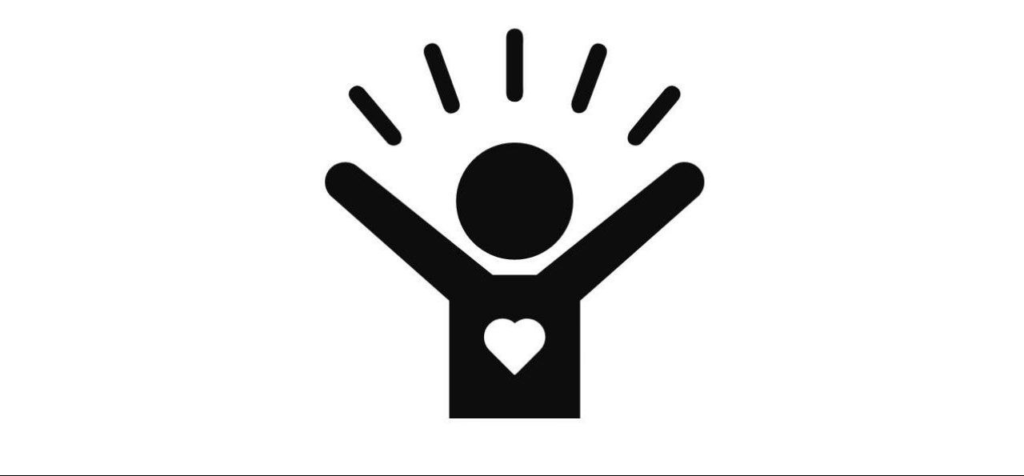
Goal: Write down 3 positive affirmations each morning for the next 21 days.
– Focuses on shifting self-perception and reinforcing self-worth.
These examples illustrate how smart goals therapy transforms vague intentions into actionable, realistic steps, tailored to each client’s mental health journey.
How to Set SMART Goals with Clients
Setting effective goals is a fundamental part of therapy. The smart goals therapy approach helps clients move forward with clarity, structure, and measurable progress.
Step 1: Start with the Client’s Vision
Begin by asking open-ended questions to understand what the client wants to achieve. It could be reducing anxiety, improving sleep, building confidence, or setting boundaries.
✅ Pro Tip: Encourage clients to describe what success looks like for them. This forms the foundation for a meaningful SMART goal.

Step 2: Make the Goal Specific
Vague goals like “feel better” or “have less stress” lack direction. In smart goals therapy, you help clients define exactly what they want to achieve.
🔹 Instead of: “I want to reduce anxiety.”
🔹 Use: “I want to reduce panic attacks from 3 per week to 1 per week.”
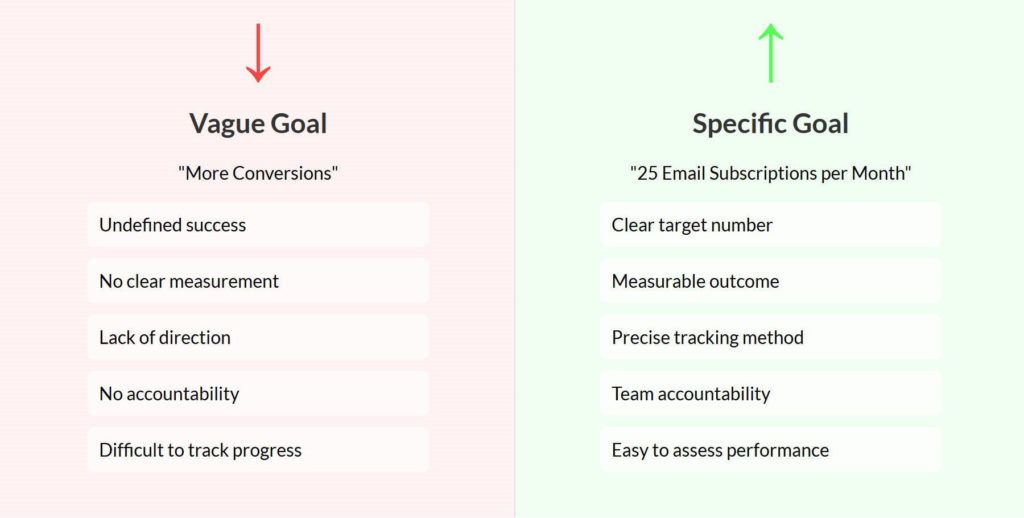
Step 3: Make It Measurable

You and your client should be able to track progress. Use numbers, behaviors, or frequency as benchmarks.
Examples:
- “Journal 4 times a week”
- “Attend 6 therapy sessions in 2 months”
- “Sleep at least 7 hours per night, 5 days a week”
Step 4: Ensure It’s Achievable
Goals should stretch the client, but not set them up for failure. Work with them to define a goal that feels realistic based on their current situation and mental state.
✅ Ask: “On a scale of 1–10, how confident do you feel about this goal?”
Adjust if the number is too low.
Step 5: Keep It Relevant
The goal must align with the client’s values and therapy objectives. Avoid imposing what you think is important—focus on what truly matters to them.
Example: A client with social anxiety might value connecting with others, so a relevant goal could be “Join one group activity this month.”
Step 6: Make It Time-Bound
Every SMART goal should have a timeline or deadline to keep things focused and actionable.
Examples:
- “By next session…”
- “In the next 30 days…”
- “Each weekday for the next 2 weeks…”
SMART Goals vs Traditional Therapy Goals
When it comes to helping clients grow and heal, how goals are set can make a big difference. In the world of smart goals therapy, goals are structured to be clear, trackable, and motivating. Traditional therapy goals, while still useful, tend to be more general and harder to measure.
Let’s break down the differences so you can see which method works best—and why SMART goals are becoming the gold standard in modern therapy.

Traditional Therapy Goals: Open-Ended and Broad
Traditional therapy goals often focus on emotional growth or insight. While meaningful, these goals can be vague and difficult to measure.
Examples of traditional goals:
- “Feel happier”
- “Improve relationships”
- “Understand my triggers”
- “Be less anxious”
These types of goals may reflect a client’s desires, but they don’t always give a clear path forward. Without specific criteria or timelines, it can be hard for clients to know if they’re making progress—or for therapists to measure success.
SMART Goals Therapy: Focused, Measurable, and Motivating
In smart goals therapy, each goal is built around the SMART framework:
Specific, Measurable, Achievable, Relevant, and Time-bound.
This structure helps clients set realistic expectations, track progress, and feel a sense of accomplishment—step by step.
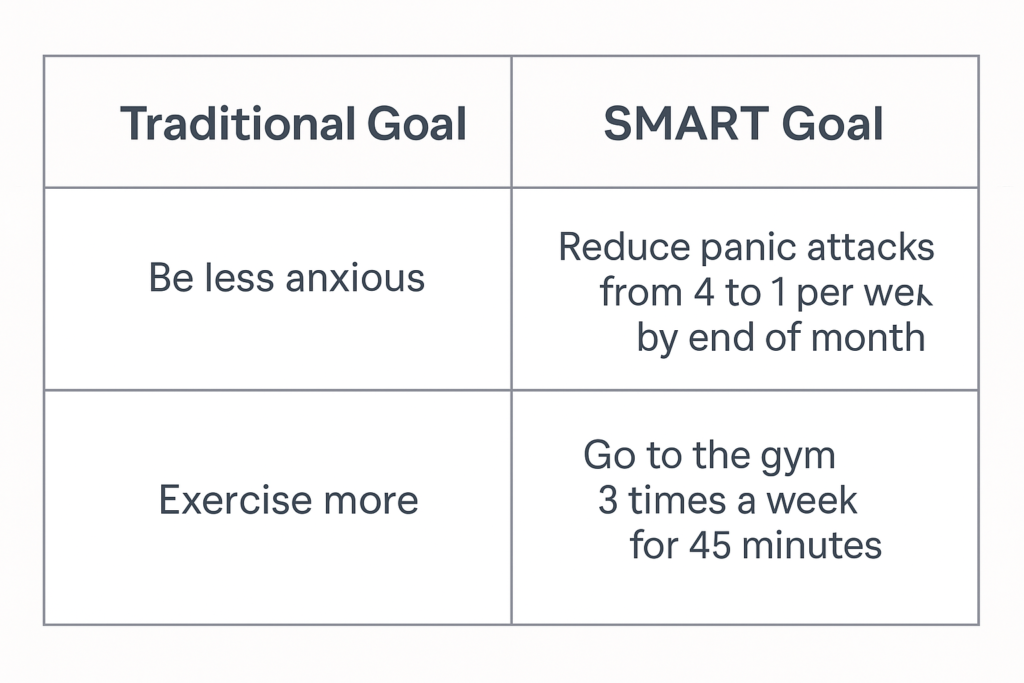
Examples of SMART goals:
- “Practice deep breathing for 5 minutes, 3 times a day for the next 2 weeks to manage anxiety.”
- “Attend one social event this month to challenge avoidance patterns.”
- “Sleep at least 7 hours a night for 4 out of 7 days next week.”
These goals are not only clear and achievable—they also reinforce progress and motivate the client to keep going.
Key Differences at a Glance
| Criteria | Traditional Goals | SMART Goals Therapy |
|---|---|---|
| Clarity | Often vague | Clearly defined |
| Progress Tracking | Difficult to measure | Easy to track and review |
| Motivation | Can feel abstract | Encourages action through small wins |
| Accountability | Less structured | Built-in deadlines and benchmarks |
| Outcome | Open-ended | Time-bound and results-focused |
Common Mistakes to Avoid

Setting goals in therapy can be incredibly effective — especially when using the SMART framework. But even in smart goals therapy, there are common pitfalls that can undermine progress if not addressed early on.
Here are the most frequent mistakes to watch out for:
1. Setting Goals That Are Too Vague
Even within the SMART model, goals can still be poorly defined. For example, “reduce stress” is too broad. Instead, say: “Practice a 5-minute breathing exercise daily for the next 3 weeks.”
2. Making Goals Unrealistically Ambitious
Overly ambitious goals can lead to disappointment and burnout. Goals should be challenging but realistic, based on the client’s current circumstances and emotional capacity.
3. Ignoring the Client’s Input
In smart goals therapy, collaboration is key. Goals should come from shared conversations — not therapist assumptions. Otherwise, clients may feel disconnected or unmotivated.
4. Forgetting to Review and Adjust Goals
SMART goals should evolve. Regularly reviewing goals keeps therapy aligned with the client’s growth and changing needs. Skipping this step can lead to outdated or irrelevant targets.
Set
↑
|
|
Adjust ←────── Review
| ↑
| |
↓ |
Act ───────────────┘
5. Focusing Only on Outcomes
While measurable results are important, focusing solely on outcomes (like “reduce anxiety by 50%”) can cause stress. Process-based goals (e.g., “attend weekly support group”) are just as valuable.
6. Writing Goals in Therapist Language
Avoid jargon or clinical language when creating goals. Use everyday words the client understands and relates to — this improves engagement and ownership.
Tools and Templates for SMART Goal Setting
One of the biggest advantages of using smart goals therapy is that it can be supported by a wide range of helpful tools and templates. These resources make it easier for therapists and clients to define, track, and adjust goals over time.
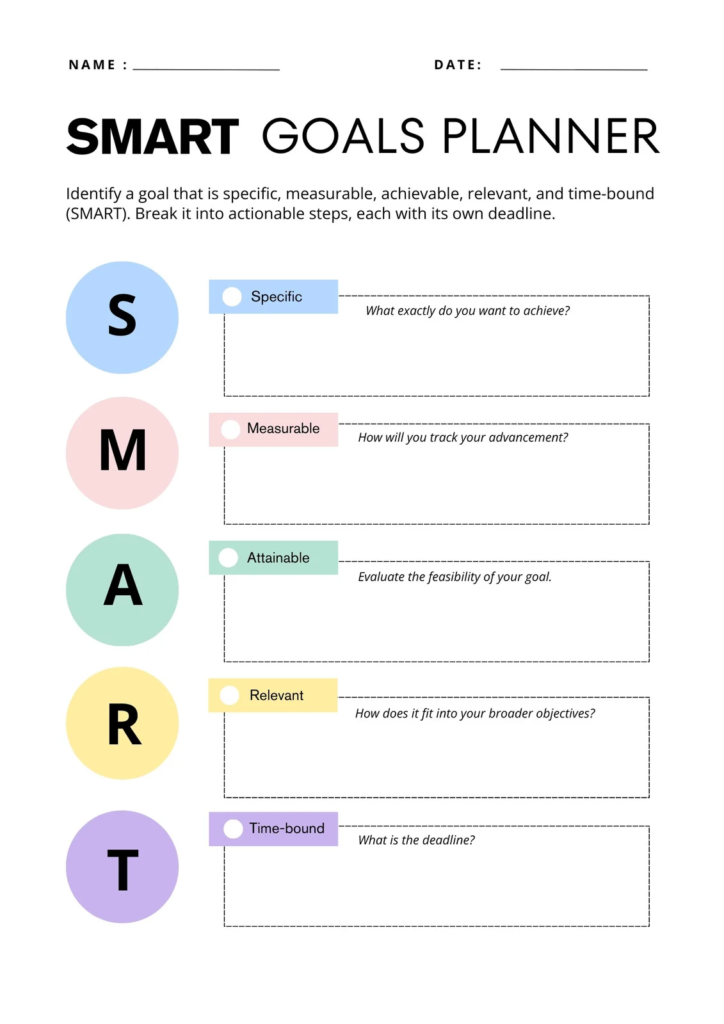
Here are some of the most effective tools you can use:
1. SMART Goal Worksheets
Printable or digital worksheets provide a structured format to write out each part of a SMART goal. They often include prompts like:
- What do you want to accomplish?
- How will you measure progress?
- Is this goal realistic for your current situation?
2. Goal-Tracking Apps
Apps like Trello, Notion, or therapy-specific tools like SimplePractice or TheraNest allow clients to set reminders, track progress, and check off completed goals.
3. Google Docs or Shared Journals
For therapists and clients who collaborate remotely, shared documents are great for updating and reviewing goals in real-time.

4. Visual Goal Boards
Digital or physical vision boards can help clients stay motivated by visualizing what they’re working toward. These work well for younger clients or those who prefer creative approaches.
5. Templates for Progress Reviews
Monthly or bi-weekly templates can help assess what’s working and what needs to be adjusted — a key step in smart goals therapy.
| Simple Review |
| ✅ What Went Well? |
|---|
| • _____________________ |
| • _____________________ |
| • _____________________ |
| 🛠️ What Will You Adjust? |
| ———————————— |
| • _____________________ |
| • _____________________ |
| • _____________________ |

SMART Goals in Online/Teletherapy Settings
Smart goals therapy is a valuable tool for therapists and clients alike, providing a clear and focused framework for achieving desired outcomes. In online/teletherapy settings, where the therapeutic relationship is mediated through technology, SMART goals take on added significance. They offer a structured approach to navigating the unique challenges and opportunities of virtual therapy.
Setting SMART Goals in Online/Teletherapy
When setting SMART goals in online/teletherapy, it’s essential to consider the unique aspects of this modality:
- Technical considerations: Ensure that the goals are achievable within the constraints of the virtual environment, taking into account factors like technology access and internet connectivity.
- Motivational factors: Address potential challenges related to motivation and engagement in online therapy, such as distractions and lack of in-person accountability.
- Cultural factors: Be mindful of cultural differences and preferences that may influence goal setting and therapeutic engagement in online settings.
Incorporating SMART Goals into Online/Teletherapy Sessions
SMART goals can be integrated into various aspects of online/teletherapy sessions:
- Session planning: Collaboratively set SMART goals at the beginning of each session, outlining specific objectives and desired outcomes.
- Progress tracking: Regularly review and adjust SMART goals based on progress and feedback, ensuring they remain relevant and motivating.
- Homework assignments: Assign homework assignments that align with SMART goals, providing opportunities for practice and skill-building between sessions.
- Feedback and evaluation: Use SMART goals as a framework for providing constructive feedback and evaluating the effectiveness of the therapeutic interventions.
Benefits of Using SMART Goals in Online/Teletherapy
By incorporating SMART goals into online/teletherapy, therapists and clients can experience several benefits:
- Enhanced focus and clarity: SMART goals provide a clear roadmap for the therapeutic journey, reducing ambiguity and uncertainty.
- Increased motivation and engagement: Setting achievable and relevant goals can boost motivation and encourage active participation in the therapeutic process.
- Improved communication and collaboration: SMART goals facilitate open and honest communication between therapist and client, fostering a strong therapeutic alliance.
- Enhanced accountability: Regularly tracking and reviewing SMART goals promotes accountability and reinforces the commitment to achieving desired outcomes.
Conclusion
Smart goals therapy offers a powerful, structured way to guide clients toward meaningful change. By setting goals that are specific, measurable, achievable, relevant, and time-bound, both therapists and clients gain clarity, motivation, and a clear path forward.
Whether you’re just beginning to integrate SMART goals into your sessions or looking to refine your approach, the tools, examples, and strategies shared in this guide can help you build more effective and engaging therapy experiences.
Remember, the success of SMART goals lies not just in setting them — but in reviewing, adapting, and celebrating the progress along the way.

